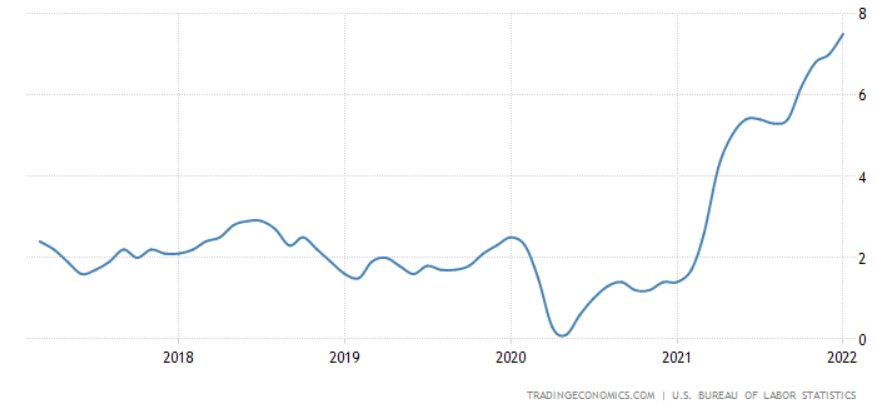The Russo-Ukrainian War and its Impact on the US Economy
By Isaac Oh and Eshan Gupta
After years of tension and clashes between Ukrainian troops and Russian-backed separatists, Russian president Vladimir Putin has begun a full-scale invasion of Ukraine, the first large-scale ground engagement in Europe since the Second World War. The stakes have never been higher in the political and strategic realms, but the effects of this war will go beyond these areas. The Russo-Ukrainian conflict has tremendous economic implications as well, with the world economy just recovering from COVID and already experiencing worrying levels of inflation.
United States Inflation Rate (Chart from TradingEconomics.com)
Already, the war between Russia and Ukraine is not limited to military engagement. In lieu of sending their troops into direct conflict with the Russian military, the US, EU, UK, and other countries allied with Ukraine have imposed sanctions on Russian banks, oligarchs with close ties to President Putin, and even Russia’s central bank. The financial assets these Russian entities possess overseas have been frozen, and individuals in these countries have been prohibited from transactions with them. Further adding to Russia’s financial woes, Ukraine’s allies have taken the drastic step of removing some Russian banks from SWIFT, a cooperative system to facilitate secure communications and transactions between banks around the world.
All of these steps are intended to punish Putin economically for his decision to invade Ukraine. With Russia’s largest financial institutions effectively fenced out of half of the global economy and its overseas wealth trapped in frozen accounts, Putin will have a much harder time funding the war against Ukraine. The goal is to plunge Russia’s economy into a severe recession, while Putin, for his part, has countered these efforts by building massive stockpiles of foreign currency and gold.
The catch, however, is that the world economy has become much more interconnected than it was a century ago. Globalization, where companies have functions in multiple countries, has taken off since the end of the Cold War. Unlike in the days of the old Soviet Union, Russia is more integrated economically with the states opposing it. Thus, a recession in Russia will produce an economic effect on the world.
For example, one of the biggest economic truths to confront is that Europe is highly dependent on Russian gas for energy. On average, countries in the European Union imported 26.9% of their crude oil and 41.1% of their natural gas from Russia in 2019. In the event of further escalation by Russia, Putin would need only to turn off the proverbial spigot, and Europe would be severely handicapped in their bargaining position. Supply-side inflation, where the limited supply of an input good drives up prices, would hit the economies of Europe, leading to higher prices, more uncertainty, and slower growth.
This reality is not lost on policymakers. Germany, for instance, has struggled for years with the political issue of Nord Stream 2, a pipeline to bring in natural gas from Russia. Only with the invasion of Ukraine has Chancellor Olaf Scholz halted certification of the project. US President Joe Biden has made it a priority “to limit the pain the American people are feeling at the gas pump.”
In these statements, it’s hard not to see echoes of another economic crisis fifty years past. In the 1970s, stagflation hit the US economy. People saw high inflation and low growth, a phenomenon that many prominent economists of the day claimed to be impossible. The cause? Many point to a restriction of oil exports from OPEC in light of America’s support for Israel in the 1973 Yom Kippur War. What followed was a decade of back-and-forth demand management, with politicians shifting between countering inflation (“Whip Inflation Now”) to recession.
Unlike in the 70s, however, America has become energy independent and no longer imports most of its energy sources from other nations. Thus, the pain it feels from a potential shut-off of Russian gas supplies will most likely be limited. The effects on Europe, however, will be much more pronounced, and the EU is one of America’s largest trading partners. Thus, a rise in prices of European goods could also lead to higher prices in the United States. In addition, with inflation already at levels not seen since the 1980s, additional inflationary pressure may push the Fed to take drastic action to take action against rising prices, potentially upsetting the already fragile economic recovery of the world. This scenario, and others, represent the hazards of war in a globalized economy.
The eventual remedy to stagflation was painful, but necessary. Federal Reserve Chair Paul Volcker adopted an aggressive tight money policy, raising the federal funds rate to near record levels. The subsequent recessions in the US economy garnered more popular condemnation for Volcker than almost any other Fed chair. In the end, however, inflation was “whipped” and growth resumed. The question today is whether or not we have the luxury of going through with a similar remedy, with COVID-19 lurking just outside the door and a globalized economy tying us all together.

